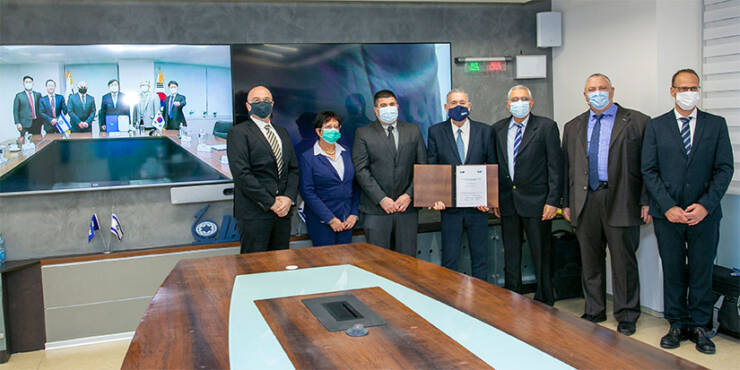
Tel Aviv. Korea Aerospace Industries (KAI) and Israel Aerospace Industries (IAI) have signed a Memorandum of Understanding (MOU) for collaboration in which the companies will offer the Republic of Korea (ROK) military forces with unmanned loitering weapon systems.
As part of the MOU, KAI and IAI are aiming to expand their long cooperation to market the loitering munitions to ROK Army requirements.
IAI’s most known loitering weapon system is the Harop. It was used extensively by Azerbaijan during the recent war with Armenia.
The Harop has been developed to destroy high quality targets. It consists of the munitions unit, transportable launcher and a mission control shelter, which provides real-time access to control the Harop by a man-in-the-loop.
The Harop can be launched from various transportable platforms including sea and ground based canisters or air launched to navigate towards the potential target area. It can be launched at any angle, horizontal or a vertical trajectory. The sealed container ensures protection from harsh battlefield conditions.
The Harop is armed with a 35 pounds warhead and is equipped with a very advanced day/night payload (POP-250) made by the Tamam division of IAI.
Harop has an operational range of 620 miles and an endurance of six hours.
IAI has upgraded the Harop. According to the company, the upgraded HAROP, demonstrated augmented capabilities in the field of observation, flight altitude and loitering, in addition to better maneuvering and target destruction.
During recent demonstrations, the system loitered for several hours until the target was selected. Then, with maximum precision it dived directly on to it.
A HAROP unit is comprised of launchers and a Mission Control Shelter (MCS) which enables missile control with a man-in-the-loop operation, engagement or abort attack capability in real time, thereby avoiding collateral damage.
This loitering system can be used in a range of battle scenarios, including low and high intensity conflict, urban warfare and counter terror operations.
HAROP is launched from transportable launchers and navigates towards the target area, where it can loiter and search for targets for up to six hours. Once a target, whether stationary or moving, is detected, it is attacked and destroyed. The attack can be performed from any direction and at any attack angle, from flat to vertical.
To date, according to IAI, hundreds of HAROP systems have been sold to different customers, for an accumulated amount of hundreds of millions of dollars.
The IAI loitering weapon systems has been used by South Korea for many years.
In 1997, the South Korean army purchased 100 Harpys in a deal valued at about $50 million. This batch has been deployed.
South Korea is negotiating a purchase of around 100 more systems. This could include developed versions with improved homing sensors to allow the Harpy to attack non-radiating targets.
Developed by IAI’s MBT division, the Harpy is in service in Israel and with other customers, including India. The weapon is ground-launched and can loiter for two hours at around 400km (215nm) from the launch point. The system is able to attack targets that have switched off the emitter. Each Harpy launcher contains 18 all-composite delta-winged drones. A typical battery contains three launchers.
The Harpy was the basis for the development of the Harop.
-The writer is an Israel-based freelance journalist








